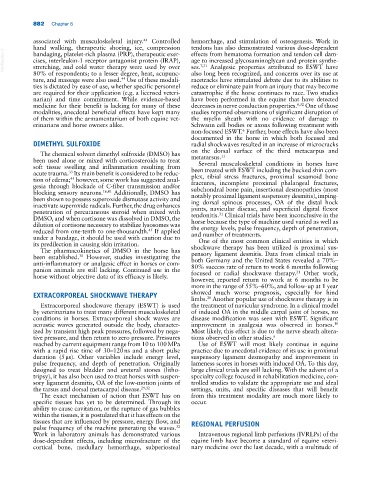Page 916 - Adams and Stashak's Lameness in Horses, 7th Edition
P. 916
882 Chapter 8
associated with musculoskeletal injury. Controlled hemorrhage, and stimulation of osteogenesis. Work in
44
hand walking, therapeutic shoeing, ice, compression tendons has also demonstrated various dose‐dependent
VetBooks.ir cises, interleukin‐1 receptor antagonist protein (IRAP), age to increased glycosaminoglycan and protein synthe-
effects from hematoma formation and tendon cell dam-
bandaging, platelet‐rich plasma (PRP), therapeutic exer-
ses.
stretching, and cold water therapy were used by over
Analgesic properties attributed to ESWT have
7,31
80% of respondents; to a lesser degree, heat, acupunc- also long been recognized, and concerns over its use at
ture, and massage were also used. Use of these modali- racetracks have stimulated debate due to its abilities to
44
ties is dictated by ease of use, whether specific personnel reduce or eliminate pain from an injury that may become
are required for their application (e.g. a licensed veteri- catastrophic if the horse continues to race. Two studies
narian) and time commitment. While evidence‐based have been performed in the equine that have detected
medicine for their benefit is lacking for many of these decreases in nerve conduction properties. 6,32 One of those
modalities, anecdotal beneficial effects have kept many studies reported observations of significant disruption of
of them within the armamentarium of both equine vet- the myelin sheath with no evidence of damage to
erinarians and horse owners alike. Schwann cell bodies or axons following treatment with
non‐focused ESWT. Further, bone effects have also been
6
documented in the horse in which both focused and
DIMETHYL SULFOXIDE radial shockwaves resulted in an increase of microcracks
on the dorsal surface of the third metacarpus and
The chemical solvent dimethyl sulfoxide (DMSO) has metatarsus. 11
been used alone or mixed with corticosteroids to treat Several musculoskeletal conditions in horses have
soft tissue swelling and inflammation resulting from been treated with ESWT including the bucked shin com-
acute trauma. Its main benefit is considered to be reduc- plex, tibial stress fractures, proximal sesamoid bone
33
tion of edema; however, some work has suggested anal- fractures, incomplete proximal phalangeal fractures,
45
gesia through blockade of C‐fiber transmission and/or subchondral bone pain, insertional desmopathies (most
blocking sensory neurons. 16,41 Additionally, DMSO has notably proximal ligament suspensory desmitis), imping-
been shown to possess superoxide dismutase activity and ing dorsal spinous processes, OA of the distal hock
inactivate superoxide radicals. Further, the drug enhances joints, navicular disease, and superficial digital flexor
penetration of percutaneous steroid when mixed with tendonitis. Clinical trials have been inconclusive in the
31
DMSO, and when cortisone was dissolved in DMSO, the horse because the type of machine used varied as well as
dilution of cortisone necessary to stabilize lysosomes was the energy levels, pulse frequency, depth of penetration,
45
reduced from one‐tenth to one‐thousandth. If applied and number of treatments.
under a bandage, it should be used with caution due to One of the most common clinical entities in which
its predilection in causing skin irritation. shockwave therapy has been utilized is proximal sus-
The pharmacokinetics of DMSO in the horse has
38
been established. However, studies investigating the pensory ligament desmitis. Data from clinical trials in
both Germany and the United States revealed a 70%–
anti‐inflammatory or analgesic effect in horses or com- 80% success rate of return to work 6 months following
panion animals are still lacking. Continued use in the focused or radial shockwave therapy. Other work,
31
horse without objective data of its efficacy is likely.
however, reported return to work at 6 months to be
more in the range of 55%–60%, and follow‐up at 1 year
EXTRACORPOREAL SHOCKWAVE THERAPY showed much worse prognosis, especially for hind
limbs. Another popular use of shockwave therapy is in
28
Extracorporeal shockwave therapy (ESWT) is used the treatment of navicular syndrome. In a clinical model
by veterinarians to treat many different musculoskeletal of induced OA in the middle carpal joint of horses, no
conditions in horses. Extracorporeal shock waves are disease modification was seen with ESWT. Significant
acoustic waves generated outside the body, character- improvement in analgesia was observed in horses.
18
ized by transient high peak pressures, followed by nega- Most likely, this effect is due to the nerve sheath altera-
tive pressure, and then return to zero pressure. Pressures tions observed in other studies. 6
reached by current equipment range from 10 to 100 MPa Use of ESWT will most likely continue in equine
with a rapid rise time of 30–120 ns and a short pulse practice due to anecdotal evidence of its use in proximal
duration (5 μs). Other variables include energy level, suspensory ligament desmopathy and improvement in
pulse frequency, and depth of penetration. Originally lameness scores in horses with induced OA. To this day,
designed to treat bladder and ureteral stones (litho- large clinical trials are still lacking. With the advent of a
tripsy), it has also been used to treat horses with suspen- specialty college focused in rehabilitation medicine, con-
sory ligament desmitis, OA of the low‐motion joints of trolled studies to validate the appropriate use and ideal
the tarsus and dorsal metacarpal disease. 29,32 settings, units, and specific diseases that will benefit
The exact mechanism of action that ESWT has on from this treatment modality are much more likely to
specific tissues has yet to be determined. Through its occur.
ability to cause cavitation, or the rupture of gas bubbles
within the tissues, it is postulated that it has effects on the
tissues that are influenced by pressure, energy flow, and REGIONAL PERFUSION
pulse frequency of the machine generating the waves.
32
Work in laboratory animals has demonstrated various Intravenous regional limb perfusions (IVRLPs) of the
dose‐dependent effects, including microfracture of the equine limb have become a standard of equine veteri-
cortical bone, medullary hemorrhage, subperiosteal nary medicine over the last decade, with a multitude of

